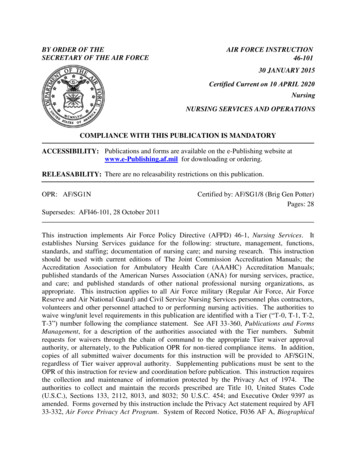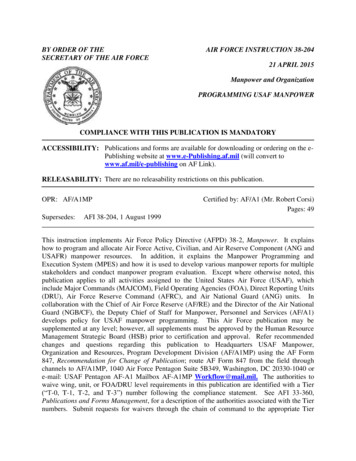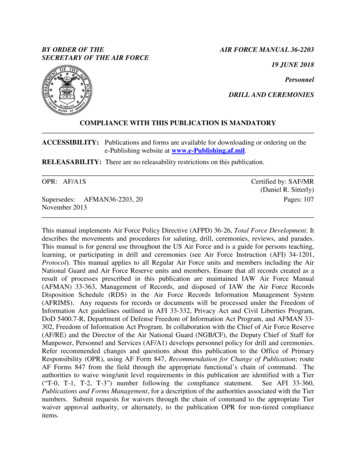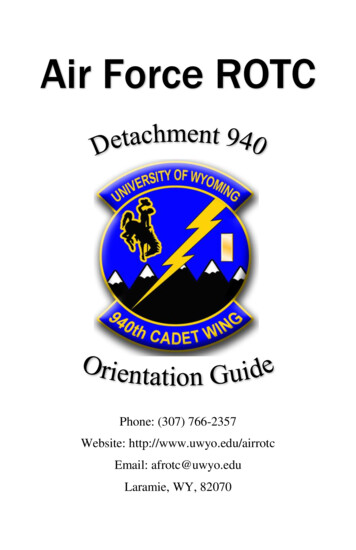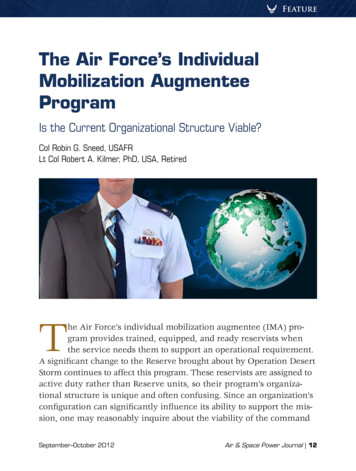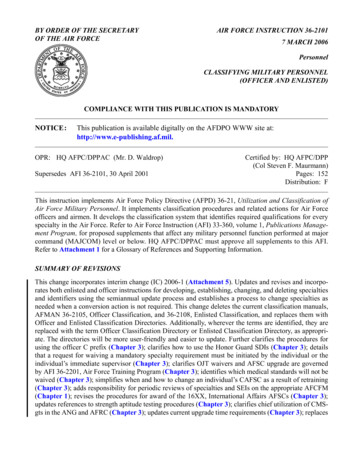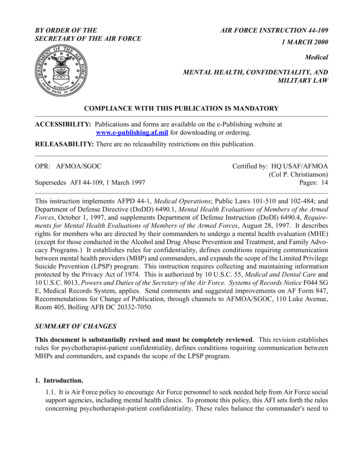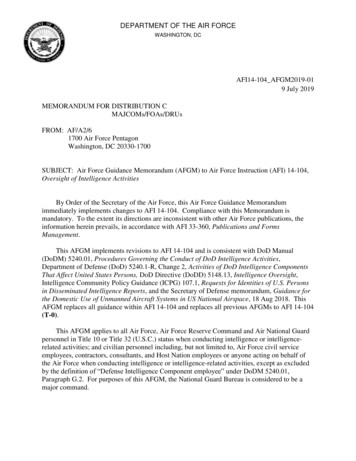
Transcription
DEPARTMENT OF THE AIR FORCEWASHINGTON, DCAFI14-104 AFGM2019-019 July 2019MEMORANDUM FOR DISTRIBUTION CMAJCOMs/FOAs/DRUsFROM: AF/A2/61700 Air Force PentagonWashington, DC 20330-1700SUBJECT: Air Force Guidance Memorandum (AFGM) to Air Force Instruction (AFI) 14-104,Oversight of Intelligence ActivitiesBy Order of the Secretary of the Air Force, this Air Force Guidance Memorandumimmediately implements changes to AFI 14-104. Compliance with this Memorandum ismandatory. To the extent its directions are inconsistent with other Air Force publications, theinformation herein prevails, in accordance with AFI 33-360, Publications and FormsManagement.This AFGM implements revisions to AFI 14-104 and is consistent with DoD Manual(DoDM) 5240.01, Procedures Governing the Conduct of DoD Intelligence Activities,Department of Defense (DoD) 5240.1-R, Change 2, Activities of DoD Intelligence ComponentsThat Affect United States Persons, DoD Directive (DoDD) 5148.13, Intelligence Oversight,Intelligence Community Policy Guidance (ICPG) 107.1, Requests for Identities of U.S. Personsin Disseminated Intelligence Reports, and the Secretary of Defense memorandum, Guidance forthe Domestic Use of Unmanned Aircraft Systems in US National Airspace, 18 Aug 2018. ThisAFGM replaces all guidance within AFI 14-104 and replaces all previous AFGMs to AFI 14-104(T-0).This AFGM applies to all Air Force, Air Force Reserve Command and Air National Guardpersonnel in Title 10 or Title 32 (U.S.C.) status when conducting intelligence or intelligencerelated activities; and civilian personnel including, but not limited to, Air Force civil serviceemployees, contractors, consultants, and Host Nation employees or anyone acting on behalf ofthe Air Force when conducting intelligence or intelligence-related activities, except as excludedby the definition of “Defense Intelligence Component employee” under DoDM 5240.01,Paragraph G.2. For purposes of this AFGM, the National Guard Bureau is considered to be amajor command.
2AFI14-104 AFGM2019-01 day month yearThis Memorandum becomes void after one year has elapsed from the date of thisMemorandum, or upon incorporation of an Interim Change or rewrite of AFI 14-104, whicheveris earlier.VERALINN JAMIESON, Lt Gen, USAFDeputy Chief of Staff,Intelligence, Surveillance,Reconnaissance & Cyber EffectsOperationsAttachments1. Guidance2. Air Force Intelligence Oversight Approval Authorities3. Requests for Identities of U.S. Persons in Disseminated Intelligence Reports
3AFI14-104 AFGM2019-01 day month yearAttachment 1GUIDANCE1. OVERVIEW. This guidance contains 49 tiered compliance statements: 35 (T-0); 14 (T-1).This guidance provides for the effective conduct of Air Force intelligence activities andintelligence-related activities and the protection of constitutional rights. All lawful means, andwith full consideration of the rights of United States persons (as defined in Executive OrderNumber 12333, United States Intelligence Activities, 4 December 1981) shall be used to obtainreliable intelligence information to protect the United States and its interests. The Air Force hasa solemn obligation, and shall continue in the conduct of its activities, to protect fully the legalrights of all United States persons, including freedoms, civil liberties, and privacy rightsguaranteed by Federal law. Individual intelligence professionals, and their unit commanders,play the most important role in this process.2. ROLES AND RESPONSIBILITIES.2.1. Deputy Chief of Staff, Intelligence, Surveillance, Reconnaissance and Cyber EffectsOperations (AF/A2/6) will:2.1.1. Serve as a Defense Intelligence Component Head in accordance with DoDM 5240.01.2.1.2. Support all Intelligence Oversight responsibilities as delegated from the Secretary of theAir Force (SecAF) to the Air Force Intelligence Oversight Officer in accordance with DoDD5148.13.2.1.3. Manage communications with the Legislative Branch on Intelligence Oversight issues inaccordance with AFI 90-401, and in consultation with the DoD Senior Intelligence OversightOfficial.2.1.4. Coordinate with SAF/IG to develop Intelligence Oversight inspection requirements forinclusion into AFI 90-201, The Air Force Inspection System.2.2. Acting Associate Deputy Chief of Staff, Intelligence, Surveillance, Reconnaissance andCyber Effects Operations (AF/AAD2/6) will:2.2.1. As appointed by the SecAF, serve as AF Intelligence Oversight Official and have accessto all component intelligence and intelligence-related activities (including those protected byspecial access programs, alternative compensatory control measures, and other securitycompartments); AF Intelligence Oversight Official has direct access to the SecAF to report onintelligence oversight compliance. The AF Intelligence Oversight Official assists the SecAF inthe administration of intelligence oversight by monitoring the accomplishment of theresponsibilities in DoDD 5148.13, para. 2.4.2.2.2. Serve as approving official for AF Intelligence Oversight reports to the DoD SeniorIntelligence Oversight Official.2.3. Air Force Inspector General (SAF/IG) will:2.3.1. In accordance with DoDD 5148.13 ensure all AF Questionable Intelligence Activities andSignificant/Highly Sensitive Matters are properly identified and investigated.2.3.2. In accordance with DoDD 5148.13 and AFI 90-201 ensure AF units conductingintelligence and intelligence-related activities are periodically inspected to ensure compliancewith all applicable federal law, E.O.s, Presidential directives, Intelligence CommunityDirectives, and DoD issuances; to determine whether any element within their respectivejurisdiction is conducting intelligence or counterintelligence activities without an assignedmission to do so; and to verify that procedures exist for reporting QIAs and S/HSMs and thatemployees are effectively trained on and consistently comply with their intelligence oversightresponsibilities.2.4. Secretary of the Air Force, General Counsel (SAF/GC) will provide interpretations ofIntelligence Oversight laws and policy for the Department of the Air Force and advise on Air
4AFI14-104 AFGM2019-01 day month yearForce Intelligence Oversight training and policy. SAF/GC will review all reports ofSignificant/Highly Sensitive Matters, if time allows, and all reports of Questionable IntelligenceActivities.2.5. The Judge Advocate General (AF/JA) will ensure appropriate legal personnel assigned toAir Force Defense Intelligence Components are trained in Intelligence Oversight laws andpolicy.2.6. MAJCOM, Numbered Air Force (NAF), Field Operating Agencies (FOA), and DirectReporting Unit (DRU) Directors of Intelligence/Staff Directors, will:2.6.1. Ensure units in the command who conduct intelligence or intelligence-related activitiesmanage an Intelligence Oversight program in accordance with DoDD 5148.13 (T-0).2.6.2. In accordance with DoDD 5148.13, ensure subordinate units administer an IntelligenceOversight training program, with initial and annual refresher content tailored to missionrequirements (T-0). Senior Intelligence Officers/Staff Directors may authorize units within thecommand to substitute Combat Support Agency Intelligence Oversight training for personnelassigned to their activities, so long as it is appropriately tailored to the organization’s mission.2.6.3. Report Questionable Intelligence Activities or Significant/Highly Sensitive Matters to theAF Intelligence Oversight Official and SAF/IG immediately (T-1).2.6.4. Appoint in writing, a primary and an alternate Intelligence Oversight Program Manager ofappropriate grade and experience to manage the Intelligence Oversight program in the command(T-1).2.6.5. MAJCOM Directors of Intelligence approve Proper Use Memorandums in accordancewith National System for Geospatial Intelligence Instruction (NSGI) 1806 (T-0).2.6.6. Ensure that processes exist within the command so that DoD personnel responsible fordrafting contract performance requirements (statements of work) for any contract under whichcontractor personnel will be conducting intelligence or intelligence-related activities orsupporting those efforts, shall ensure that the contract requires contractor personnel to report anyQIA or S/HSM to appropriate Government officials identified in the contract (T-0).2.7. MAJCOM, FOA, Direct Reporting Unit (DRUs), and Wing Inspectors General (IG)will:2.7.1. Identify and ensure investigations of reported Questionable Intelligence Activities and/orSignificant/Highly Sensitive Matters as applicable and immediately notify their associatedIntelligence Oversight program managers and legal counsel (T-1).2.7.2. Appoint an IG Intelligence Oversight representative responsible for by-law IntelligenceOversight compliance inspections in accordance with AFI 90-201 (T-1).2.8. MAJCOM, FOA, and Direct Reporting Unit (DRU) Staff Judge Advocates/LegalAdvisors will:2.8.1. In coordination with MAJCOM IGs, Commanders, and IOPMs, provide legal advice onreported Questionable Intelligence Activities and/or Significant/Highly Sensitive Matters (T-1).As needed, consult with SAF/GC on IO law or policy interpretations (T-0).2.8.2. Understand assigned organizational missions and provide counsel concerning IntelligenceOversight law and policy (T-1).2.9. Commanders/Directors of All AF Organizations and Units That Conduct Intelligenceor Intelligence-related Activities will:2.9.1. Ensure compliance with all Intelligence Oversight rules when conducting intelligence orintelligence-related activities (T-0).2.9.2. As appropriate, appoint Intelligence Oversight Monitors (primary and alternate) ofappropriate grade and experience to manage the Intelligence Oversight program (T-1).
AFI14-104 AFGM2019-01 day month year52.9.3. Identify and report all Questionable Intelligence Activities and/or Significant/HighlySensitive Matters through their respective chain of command, IG, legal counsel, and IntelligenceOversight program managers to AF/A2/6 (T-0).2.9.4 Ensure that no adverse action is taken against any DoD personnel or DoD contractorpersonnel because they intend to report, report, or reported what they reasonably believe is aQuestionable Intelligence Activities and/or Significant/Highly Sensitive Matters (T-0).2.9.5. If the unit conducts queries of unevaluated information that is intended to reveal USPI,then establish written procedures to document the basis for conducting such queries (T-0).2.9.6. In accordance with DoDD 5148.13, administer an effective Intelligence Oversight trainingprogram, with initial and annual refresher content tailored to mission requirements (T-0).Intelligence Oversight Monitors and/or Unit Training Managers will document assignedpersonnel’s Intelligence Oversight training (T-1).2.9.7 In accordance with AFI 90-201, annually inspect Intelligence Oversight programs forcompliance (T-1). AF-assigned units will use the HAF Intelligence Oversight self-assessmentchecklist available within the Management Internal Control Tool (T-1).2.10. All Airmen Who Conduct Intelligence and Intelligence-Related Activities for the AF,and Any Person Who Conducts Intelligence and Intelligence-Related Activities on Behalf ofthe AF will:2.10.1. Conduct all assigned intelligence and/or intelligence-related activities in accordance withall applicable laws and policies (T-1).2.10.2. Report Questionable Intelligence Activities or Significant/Highly Sensitive Matters totheir chain of command or supervision immediately (T-0). If it is not practical to reportQuestionable Intelligence Activities and/or Significant/Highly Sensitive Matters to the chain ofcommand or supervision, report to any AF legal counsel or IG; the General Counsel for DoD; theDoD Senior Intelligence Oversight Official; the Joint Staff IG or Intelligence Oversight officer;the Legal Counsel to the Chairman of the Joint Chiefs of Staff; the IG DoD; or the IntelligenceCommunity IG (T-0).3. IDENTIFYING, INVESTIGATING AND REPORTING QUESTIONABLEINTELLIGENCE ACTIVITIES AND/OR SIGNIFICANT/HIGHLY SENSITIVEMATTERS.3.1. Identification, investigation, and reporting of Questionable Intelligence Activities and/orSignificant/Highly Sensitive Matters will follow procedures outlined in DoDD 5148.13, Sec. 4(T-0).3.2. MAJCOM, FOA, or DRU Intelligence Oversight Program Managers must submit quarterlyinputs to the AF/A2/6 Intelligence Oversight Program Manager NLT two business days after theend of each quarter (T-1). The AF/A2/6 Intelligence Oversight Program Manager consolidatesall inputs into a single AF report after coordinating with SAF/GC and SAF/IG. The AFIntelligence Oversight Official provides the quarterly report to the DoD Senior IntelligenceOversight Official.3.3. AF personnel assigned to non-AF organizations who report Questionable IntelligenceActivities or Significant/Highly Sensitive Matters to their duty organization are encouraged toreport to AF Intelligence Oversight Official or their AF Element commander for reporting to theAF Intelligence Oversight Official. The AF Intelligence Oversight Official will not report theseto the DoD Senior Intelligence Oversight Official.4. INTELLIGENCE OVERSIGHT PROCEDURAL GUIDANCE.4.1. DoDM 5240.01, DoD 5240.1-R, Chg 2, and the classified annex of DoD 5240.1-R establishprocedures to enable DoD to conduct authorized intelligence activities in a manner that protectsthe constitutional and legal rights and the privacy and civil liberties of U.S. persons, while
6AFI14-104 AFGM2019-01 day month yearproviding timely, accurate, and insightful information about the activities, capabilities, plans, andintentions of foreign powers, organizations, and persons, and their agents.4.2. In accordance with DoDM 5240.01, all Intelligence Oversight procedural approvals are sentto Defense Intelligence Component Heads or delegees as outlined in Attachment 2.4.3. Domestic Imagery: All AF requests and/or taskings for overhead domestic imagery fromthe National Geospational Agency (NGA) will be in accordance with NSGPM 1806. All AFrequests for domestic imagery will have their servicing legal office conduct a legal review and ifrequired, get a proper use memorandum approved (T-0).4.3.1. Unmanned Aircraft Systems activities: Collection, retention, and dissemination of dataand/or imagery during domestic AF Unmanned Aircraft Systems employment for intelligence orcounterintelligence purposes in accordance with DoDM 5240.01, Procedures Governing theConduct of DoD Intelligence Activities and this guidance. Domestic AF Unmanned AircraftSystems flights conducting intelligence or intelligence-related activities require a proper usememorandum. All domestic AF Unmanned Aircraft Systems flights follow applicableprocedures outlined in AFI 11-502, Volume 3, Small Unmanned Aircraft Systems Operationsand the Secretary of Defense memorandum, Guidance for the Domestic Use of UnmannedAircraft Systems in US National Airspace.4.3.2. Manned weapon systems activities: AF units operating aircraft with sensors that are usedfor intelligence purposes, including training for intelligence use, must comply with DoDM5240.01 and para 4.3 of this AFGM, as applicable (T-0). This does not apply to sensors wheretheir primary function is to provide immediate-use targeting data. Any stored imagery will notbe retrieved by reference to U.S. Persons (T-0).4.3.3. Proper Use Memorandums. An approved proper use memorandum must be on file withthe appropriate Combatant Command, per their procedures, or with the appropriate AFMAJCOM or FOA (or delegated/designated sub-component authority) before any airborne ortactical DoD satellite platforms, can be tasked to collect domestic imagery (T-0). TacticalSatellites are considered “airborne” platforms and so approval authority does not reside withNGA. MAJCOM and FOA Directors of Intelligence/Staff Directors may approve requests, afterlegal review at the MAJCOM/FOA level. In the event of an emergency or crisis where USNorthern Command is designated as lead DoD Operational Authority, all related requests fordomestic imagery from airborne or tactical DoD satellite platforms must be coordinated with USNorthern Command to ensure compliance with proper use provisions (T-0). AF organizationswill use MAJCOM-developed templates (T-1).4.4. Publically Available Information: All AF Intelligence Activities which collect, retain, ordisseminate publically available information follow procedures within DoDM 5240.01.
AFI14-104 AFGM2019-01 day month year7Attachment 2INTELLIGENCE OVERSIGHT APPROVAL AUTHORITIESFigure A.2.1. Intelligence Oversight Approval AuthoritiesIntelligence Oversight Approval AuthoritiesProcedure #Item #Procedure 2,CollectionApprove USPI Collection: Threatsto SafetyApprove USPI SpecialCircumstance CollectionApprove collecting foreignintelligence concerning U.S.persons within the United StatesProcedure 3,RetentionProcedure 4,DisseminationApprove extended Retention ofcollected termine the need for enhancedretention safeguards to protectUSPIImplementation of enhancedretention safeguards to protectUSPIDetermine dissemination of USPIto Foreign Governments orInternational OrganizationsDetermine dissemination of USPIto an entity for the limited purposeof assisting the defense componentAssess risk of USPI disseminationfor protective purposesApprove dissemination of largeamounts of unevaluated USPIProcedure 5,ElectronicSurveillanceApprove dissemination of USPI notfor FI, CI, security, lawenforcement, cybersecurity,humanitarian assistance, disasterrelief, threats to safety or protectivepurposeNotify officials intent to conductelectronic surveillance inemergency situations (requires USAttorney General approval 2/625 AF/CCAFOSI/CCAF/A2/625 AF/CCAFOSI/CCAF/A2/625 AF/CCAFOSI/CCAF/A2/625 AF/CCAFOSI/CCSingle DelegeeMultipleDelegeesAF/AAD2/625 AF/CVICON CTR/CCAF/AAD2/625 AF/CVICON CTR/CCAF/AAD2/625 AF/CVICON CTR/CCAF/AAD2/625 AF/CVICON CTR/CCNote 1AF/A2/625 AF/CCAFOSI/CCAF/A2/625 AF/CCAFOSIAF/A2/625 AF/CCAFOSI/CCAF/A2/625 AF/CCAFOSI/CCAF/A2/625 AF/CCAFOSI/CCAF/A2/625 AF/CCAFOSI/CCAF/A2/625 AF/CCAFOSI/CCAF/A2/625 bNote 1Note 5).aAF/AAD2/625 AF/CVICON CTR/CCAF/AAD2/625 AF/CVICON CTR/CCAF/AAD2/625 AF/CVICON CTR/CCAF/AAD2/625 AF/CVICON CTR/CCAF/AAD2/625 AF/CVICON CTR/CCAF/AAD2/625 AF/CVICON CTR/CCAF/AAD2/625 AF/CVICON CTR/CCNote 13.3.g.(1)Note 13.3.g.(2)Note 13.4.c.(6).cNote 13.4.c.(7)Note 13.4.c.(8)NotAuthorized3.4.dNote 13.4.fAF/AAD2/625 AF/CVICON CTR/CCNote 13.5.g.(1)
8AFI14-104 AFGM2019-01 day month yearAuthorize continued electronicsurveillance (up to 72 hours) of aforeign person outside U.S. whothen enters the U.S. (Emergencysituations)Approve concealed monitoring of aU.S. person outside the U.S.AF/A2/625 AF/CCAFOSI/CCNot AuthorizedNotAuthorized3.5.g.(2)AF/A2/625 AF/CCAFOSI/CCAF/AAD2/625 AF/CVICON CTR/CCNote 13.6.c.(3)Procedure 7,PhysicalSearchesApprove emergency physicalsearches under FISA (DIC with CIinvestigation authority only)AFOSI/CCICON CTR/CCNote 13.7.c.(3)Procedure 8,Mail SearchesRefer to Procedure 7.AFOSI/CCICON CTR/CCNote 13.8Approve nonconsensual physicalsurveillance in the U.S.AF/A2/6AF/AAD2/6Note 125 AF/CC25 AF/CV3.9.c.(1).cthru3.9.c.(1).dAFOSI/CCICON CTR/CCAF/A2/625 AF/CCAFOSI/CCAF/A2/6AF/AAD2/625 AF/CVICON CTR/CCAF/AAD2/6Note 13.9.c.(2).cNote 13.10.f.(2)25 AF/CC25 AF/CVAFOSI/CCICON CTR/CCAF/A2/625 AF/CCAFOSI/CCAF/AAD2/625 AF/CVICON CTR/CCNotAuthorized3.10.f.(3)Procedure 6,ConcealedMonitoringProcedure 8,Mail CoverProcedure 9,PhysicalSurveillanceApprove nonconsensual physicalsurveillance of a U.S. personoutside the U.S.Procedure 10,UndisclosedParticipation inOrganizations(UDP)Approve types of UDP: Non-U.S.Persons as Sources of Assistance;Public Forums; Cover Activities;U.S. Person Organizations Outsidethe United StatesApprove specific types of sensitiveUDP (i.e. collection of specificUSPI inside the U.S. for CIpurposes)Note 1: Additional delegations are authorized only by the Head of the Defense Intelligence Component.Units requesting additional delegations from the Head of the Defense Intelligence Components requestthem by name, position, grade, or function and must balance the need for speed in decision making withthe need for experienced judgment. Additional delegees are typically in the grade of O-6 or equivalent.Note 2: Delegees must inform the appropriate Head of the Defense Intelligence Component through thechain of command when approving action under this rule, in order to allow the Head of the DefenseIntelligence Component to report to the DoD Senior Intelligence Oversight Official (T-0).
AFI14-104 AFGM2019-01 day month year9Attachment 3REQUESTS FOR IDENTITIES OF U.S. PERSONS IN DISSEMINATEDINTELLIGENCE REPORTS1. This policy applies exclusively to requests from a requesting entity, other than the Air Force,for post-publication release and dissemination of nonpublic U.S. person identity information thatwas masked in a disseminated Air Force report. This policy does not apply in circumstanceswhere a U.S. person has consented to the dissemination of reporting to, from, or about the U.S.person (T-0).2. All disseminations must comply with DoDM 5240.01 and, where applicable, Annex A,Dissemination of Congressional Identity Information, of Intelligence Community Directive 112,Congressional Notification, or any other applicable provisions of law or policy (T-0).3. The office receiving the unmasking request shall document (T-0).a. The name, title, organization, and contact information of the person making the request.b. Information that identifies the Air Force report that contains the requested information.c. The name or title of each individual who will receive the U.S. person identity informationat the time of release.d. The accountable people under this Paragraph may not be contractors.e. A fact-based justification describing why the unmasked U.S. person identity information isrequired to carry out the official duties of each person receiving the information.4. Requests covered by this policy shall be approved only by the AF/A2/6, AF/AAD2/6,25AF/CC, or for AFOSI, the Commander or the ICON Center Commander (T-0).5. In the event of exigent circumstances or where a delay could negatively impact intelligenceactivities, the information to support the process in Paragraphs 3 and 4 above may be providedverbally. However, within 5 business days after approval, the requesting entity must provideinformation needed to comply with Paragraph 3 (T-0). Immediately after that, the Air Forceoffice receiving the request must process the approval under Paragraph 4 (T-0).6. When an Air Force report contains information that identifies a U.S. person but thatinformation was originated by a source other that the Air Force, the office receiving theunmasking request shall promptly refer the request to the originating entity and inform therequester (T-0).7. For any requests made between a general election for President and the inauguration of suchPresident, inclusive, in addition to the requirements above.a. The requester must assert in writing whether or not the requester has a knowledge or beliefthat any U.S. person identity information sought is of an individual who is a member of thetransition team as identified by the President-elect or Vice President-elect (T-0).b. An Air Force official considering an unmasking request must document any knowledge orreasonable belief that any U.S. person identity information sought by the request is of an
10AFI14-104 AFGM2019-01 day month yearindividual who is a member of the transition team as identified by the President-elect or VicePresident-elect (T-0).c. If such knowledge or belief exists, the unmasking approval shall be subject to theconcurrence of the Air Force General Counsel (or in the absence of the General Counsel, thePrincipal Deputy General Counsel (T-0).d. Consistent with due regard for the protection from unauthorized disclosure of classifiedinformation relating to sensitive intelligence sources and methods or other exceptionallysensitive matters, AF/A2/6, for itself and on behalf of AFOSI, in accordance with Air Force ruleson relations with Congress, and in consultation with the Director of National Intelligence, shallnotify the chairmen and ranking minority members of the congressional intelligence committeesof any unmasking approval within 14 days (T-0).8. All requests and approval actions shall be forwarded to AF/A2/6’s appointed Air ForceIntelligence Oversight Program Manager, who shall retain the request and the information inParagraphs 3-5 and 7 for not less than 5 years and then shall archive them as permanent records(T-0).9. Not later than 1 March of each year, beginning in 2019, the AF/A2/6 shall submit to theDirector of National Intelligence, the congressional intelligence committees, and, through theDoD Senior Intelligence Oversight Official, the Secretary of Defense a report in accordance withIntelligence Community Policy Guidance 107.1, Request for Identities of U.S. Persons inDisseminated Intelligence Reports (T-0). The report will document the following items for thepreceding calendar year (T-0):a. The number of requests that the Air Force received, approved, and denied.b. The same information for each requesting entity.DEFINITIONS (for purposes of this Attachment only)Requesting Entity: An entity of the U.S. Government or a state, local, tribal, or territorialgovernment that makes a request that is subject to this policy.Masked: The use of alternate or generic wording in data subject to dissemination that does notpermit the reader to ascertain the identity of a U.S. person that appeared in an intelligence report.U.S. Person: See DoDM 5240.01.U.S. Person Identity Information: U.S. person information, as defined in DoD Manual5240.01, “Procedures Governing the Conduct of DoD Intelligence Activities,” dated 8 August2016.Exigent Circumstances: Circumstances when there is a reasonable basis to believe that there isimminent danger to a person's life or physical safety or when there are time-critical needs thatpose significant risks to important U.S. interests.
BY ORDER OF THESECRETARY OF THE AIR FORCEAIR FORCE INSTRUCTION 14-1045 NOVEMBER 2014IntelligenceOVERSIGHT OF INTELLIGENCEACTIVITIESCOMPLIANCE WITH THIS PUBLICATION IS MANDATORYACCESSIBILITY: Publications and forms are available for downloading or ordering on the ePublishing website at www.e-publishing.af.mil.RELEASABILITY: There are no releasability restrictions on this publication.OPR: AF/A2ZSSupersedes:AFI 14-104, 23 April 2012Certified by: AF/A2Z(Mr. Joseph D. Yount)Pages: 26This publication implements Air Force Policy Directive (AFPD) 14-1, Intelligence, Surveillance,and Reconnaissance (ISR) Planning, Resources, and Operations and is consistent with ExecutiveOrder (EO) 12333 (part 2), United States Intelligence Activities; Department of Defense (DoD)Regulation 5240.1-R, Procedures Governing the Activities of DoD Intelligence Components ThatAffect United States Persons; DoD Directive, and (DoDD) 5240.1, DoD Intelligence Activities.It states the requirements for United States Air Force (AF) intelligence oversight activities anddescribes mandatory intelligence oversight-associated training requirements for AF componentsthat conduct intelligence activities. It also details how to identify, investigate, and report in theevent of possible Intelligence Oversight (IO) violations. In this publication, the term“intelligence” refers to intelligence and counterintelligence units and associated activities. Thispublication does not apply to criminal investigative activities. For purposes of this publication,the National Guard Bureau is considered to be a major command (MAJCOM). This instructionapplies to all AF, Air Force Reserve Command(AFRC) and Air National Guard (ANG) [in Title10 or Title 32 (U.S.C.) status when assigned or attached to intelligence units or staffs]; andcivilian personnel including, but not limited to, civil service, contract, consultants, and HostNation employees engaged in or performing intelligence-related activities. Ensure that allrecords created as a result of processes prescribed in this publication are maintained IAW AirForce Manual (AFMAN) 33-363, Management of Records, and disposed of IAW Air ForceRecords Information Management System (AFRIMS) Records Disposition Schedule (RDS).Refer recommended changes and questions about this publication to the Office of PrimaryResponsibility (OPR) using the AF Form 847, Recommendation for Change of Publication; routeAF Forms 847 from the field through the appropriate functional chain of command. Thispublication may be supplemented at any level, but all direct Supplements must be routed to theOPR of this publication for coordination prior to certification and approval. IAW Air Force
2AFI14-104 5 NOVEMBER 2014Instruction (AFI) 33-360, Publications and Forms Management, tier levels (“T-0, T-1, T-2, T3”) following compliance statements determine the appropriate authority from which waiversmust be requested. Submit requests for waivers through the chain of command to the appropriateTier waiver approval authority, or alternately, to the Publication OPR for non-tiered complianceitems.SUMMARY OF CHANGESThis publication has been substantially revised and must be completely reviewed. It adds riskfactors, known as “tiers” to tasks assigned to organizations below MAJCOM level to depict theassessed risk of non-compliance. Additional changes within this rewrite include: revising IOresponsibilities, removing annual reporting requirements IAW ATSD (IO) guidance, andupdating Proper Use Memorandum (PUM) guidance. Annual training requirements have alsobeen substantially revised to eliminate unnecessary duplication of training. AF membersassigned to non-AF agencies are now eligible for exemption from the AF IO computer basedtraining (CBT) if the non-AF agency requires comple
Air Force Defense Intelligence Components are trained in Intelligence Oversight laws and policy. 2.6. MAJCOM, Numbered Air Force (NAF), Field Operating Agencies (FOA), and Direct . with National System for Geospatial Intelligence Instruction (NSGI) 1806 (T-0). 2.6.6. Ensure that processes exist within the command so that DoD personnel .


